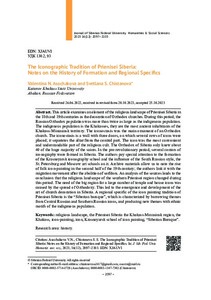The Iconographic Tradition of Prienisei Siberia: Notes on the History of Formation and Regional Specifics
Автор:
Asochakova, Valentina N.
Chistanova, Svetlana S.
Асочакова, В. Н.
Чистанова, С. С.
Дата:
2023-12Журнал:
Журнал Сибирского федерального университета. 2023 16(12). Journal of Siberian Federal University.Humanities & Social Sciences 2023 16(12)Аннотация:
This article examines an element of the religious landscape of Prienisei Siberia in
the 18th and 19th centuries as the decoration of Orthodox churches. During this period, the
Russian Orthodox population was more than twice as large as the indigenous population.
The indigenous population is the Khakasses, they are the most ancient inhabitants of the
Khakass-Minusinsk territory. The iconostasis was the main ornament of an Orthodox
church. The iconostasis is a wall with three doors, on which several rows of icons were
placed; it separates the altar from the central part. The icon was the most convenient
and understandable part of the religious cult. The Orthodox of Siberia only knew about
40 of the huge majority of the saints. In the pre-revolutionary period, several centers of
iconography were formed in Siberia. The authors pay special attention to the formation
of the Krasnoyarsk iconography school and the influence of the South Russian style, the
St. Petersburg and Moscow art schools on it. Archive materials allow us to note the rise
of folk icon-painting in the second half of the 19th century; the authors link it with the
migration movement after the abolition of serfdom. An analysis of the sources leads to the
conclusion that the religious landscape of the southern Prienisei region changed during
this period. The need of the big region for a large number of temple and house icons was
caused by the spread of Orthodoxy. This led to the emergence and development of the
art of church decoration in Siberia. A regional specific of the icon painting tradition of
Prienisei Siberia is the “Siberian baroque”, which is characterized by borrowing themes
from Central Russian and Southern Russian icons, and producing new themes with ethnic
motifs of the indigenous population Данная статья исследует такой элемент религиозного ландшафта
Приенисейской Сибири XVIII–XIX вв., как убранство церковных храмов. В указанный
период русское православное население в два с лишним раза превышало коренное.
Коренное население – хакасы, являются самым древним населением Хакасско-
Минусинского края, в этногенезе хакасов принимали участие группы тюркского,
кетского, самодийского и монгольского происхождения. Главным украшением
православного храма был иконостас. Икона являлась наиболее удобной и понятной
частью религиозного культа. Православным Сибири из громадного большинства
святых было известно всего около 40. В дореволюционный период в Сибири
сложилось несколько центров иконописания. Авторы уделяют особое внимание
формированию красноярской школы иконописи, влиянию на нее южнорусского
стиля, петербуржской, московской художественной школ. Архивные материалы
позволяют отметить подъем народного иконописания во второй половине XIX в.,
авторы связывают его с переселенческим движением после отмены крепостного
права. Анализ источников позволяет сделать вывод об изменении религиозного
ландшафта юга Приенисейского края в описываемый период. Потребность
огромного края в большом количестве храмовых и домовых икон была вызвана
распространением православия. Это привело к появлению и развитию в Сибири
искусства по изготовлению церковного убранства. Особенность иконописной традиции
Приенисейской Сибири выражается в «Сибирском барокко», которое характеризуется
заимствованием сюжетов среднерусских и южнорусских икон, продуцированием
новых тем с этническими мотивами коренного населения
Коллекции:
Метаданные:
Показать полную информациюСвязанные материалы
Показаны похожие ресурсы по названию, автору или тематике.
-
Уральское старообрядческое иконописание: зарождение, эволюция, стилистические особенности (историографический аспект)
Трофимова, Н.В.; Trofimova, Natalia V. (Сибирский федеральный университет. Siberian Federal University., 2011-01)The present article is devoted to the analysis of research points of view on a set of questions in the field of Old Russian icon-painting traditions of the Ural study. Special attention in the analysis was paid to the ... -
Isomorphic and Allomorphic Features of Iconic Units (Based on Turkish Onomatopes)
Krasnova, Anna V.; Краснова, А.В. (Сибирский федеральный университет. Siberian Federal University, 2018-02)Despite the long history of studying the iconicity phenomenon, the onomatopoeic and sound symbolic words have acquired the status of linguistic universal in a relatively recent past. In the Turkish linguistic tradition, ... -
Simbolization of the Self in Novgorod Monasticism Traditions: Archetypal and Social Aspects
Nekita, Andrey G.; Malenko, Segey A.; Некита, А.Г; Маленко, С.А. (Сибирский федеральный университет. Siberian Federal University, 2015-06)The paper analyses archetypal and socio-cultural foundations of Russian monasticism as a cultural phenomenon of the Novgorod land to determine its effect on the formation of the spiritual traditions of the Northwest ... -
Tackling the Problem of Translation of Turkish Phonetically Motivated Units
Bartashova, Olga A.; Krasnova, Anna V.; Барташова, О.А.; Краснова, А.В. (Сибирский федеральный университет. Siberian Federal University., 2015-02)The article is dedicated to the problem of Turkish-English phonosemantic parallels from the point of translation. In past researches were likely to view iconic units as untranslatable ones, which led to a variety of ... -
The Phoneme and the Phonotype
Brodovich, Olga I.; Бродович, О.И. (Сибирский федеральный университет. Siberian Federal University., 2016-03)The paper has as its aim to show that in cases of sound symbolism and onomatopoeia the meaningful entities are not phonemes in the entirety of their phonetic features, but concrete features reflecting the sound-shape or ...

